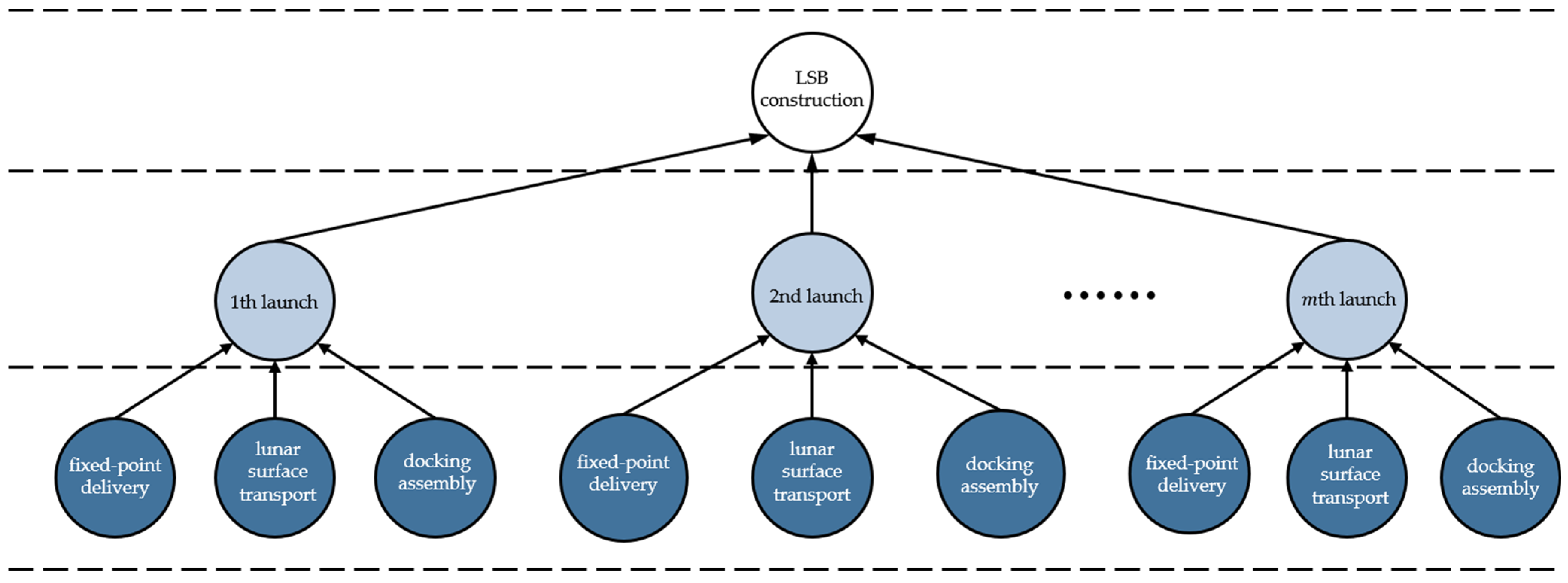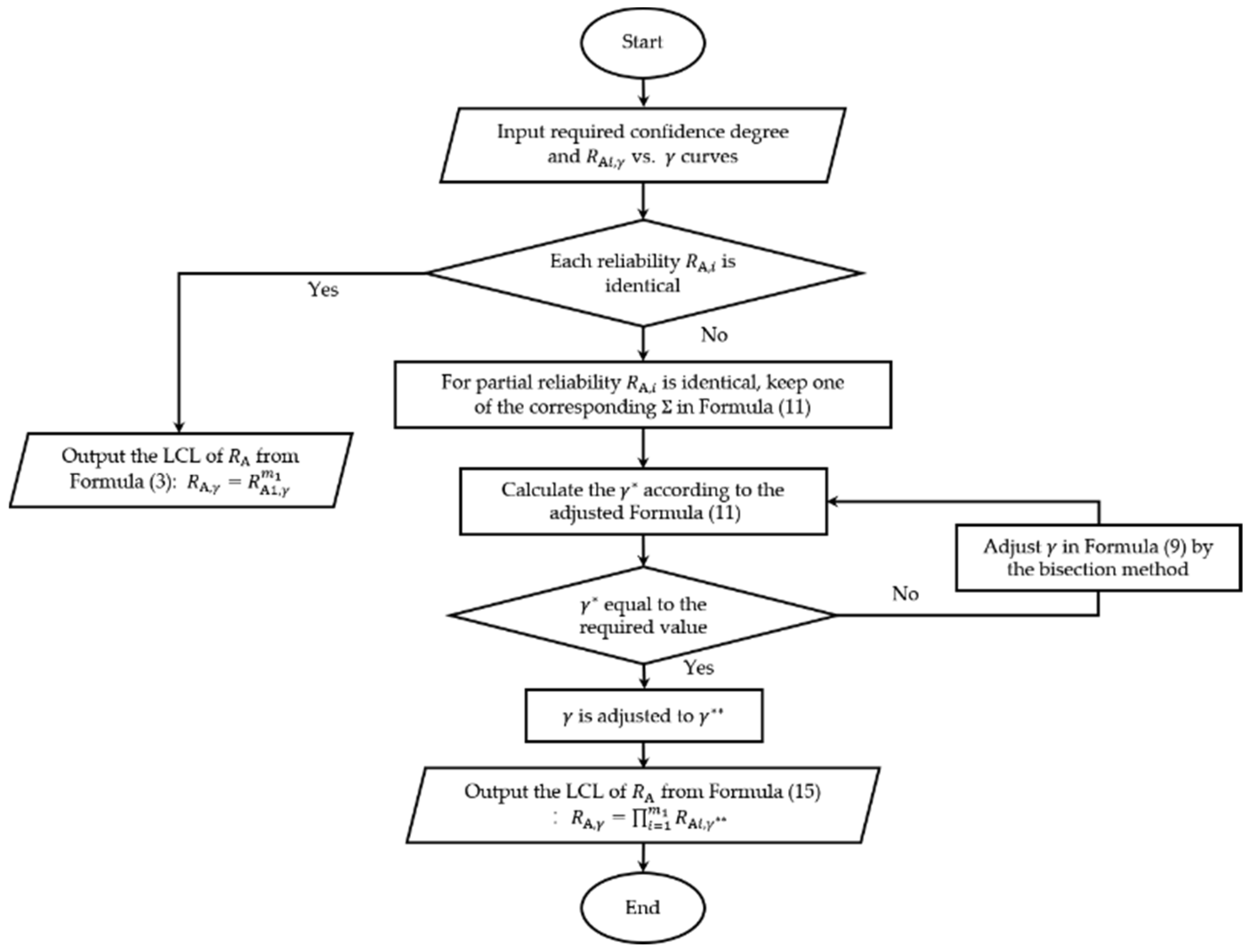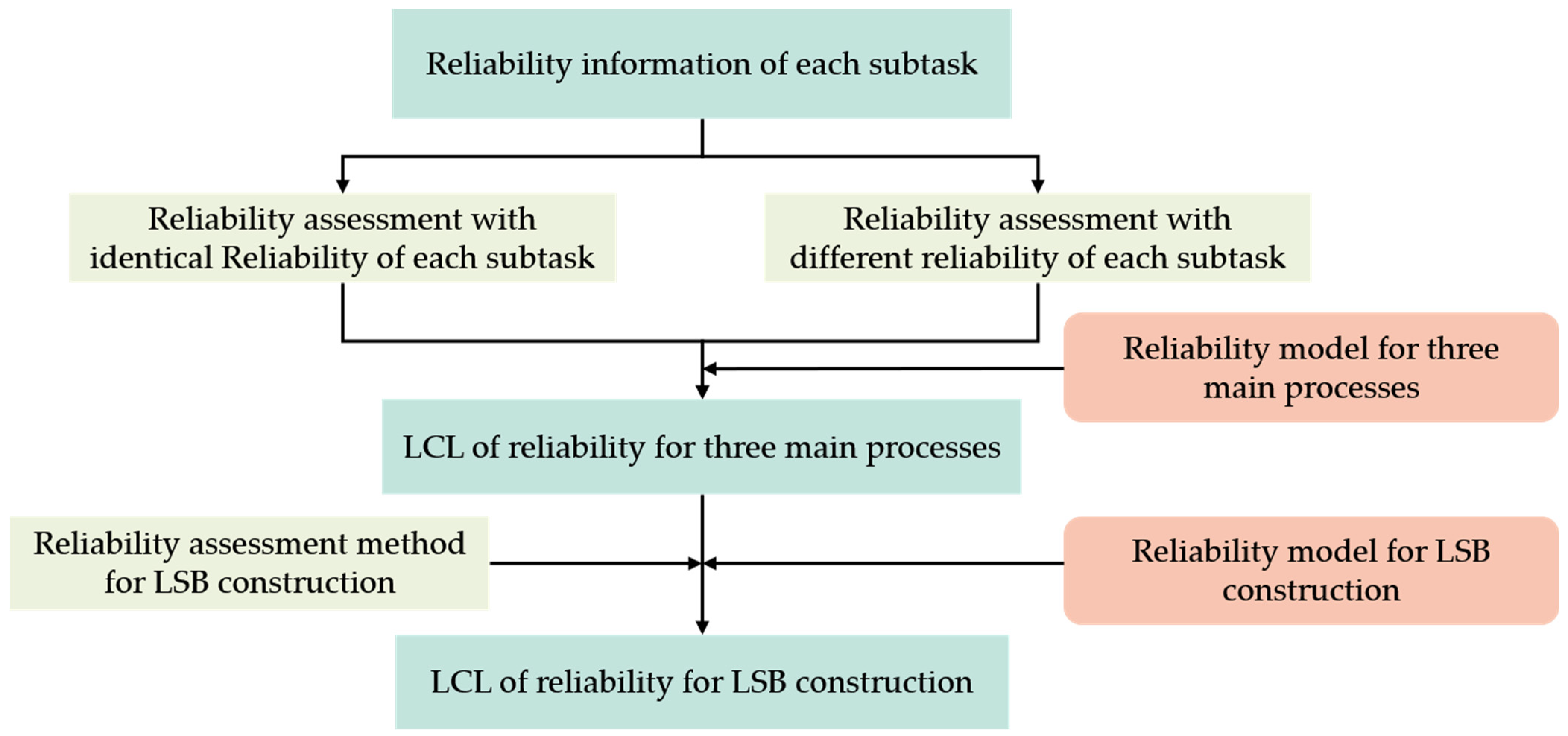Phased System Reliability Modeling and Assessment for Construction of Lunar Scientific Base
Abstract
:1. Introduction
2. A Phased Reliability Model for LSB Construction
3. Reliability Assessment Method for Three Main Processes
- (1)
- If the reliability confidence limits of subtasks are inferred from the same test samples, it can be said that they have identical reliability; in other words, the reliability confidence limits are correlated.
- (2)
- If the reliability confidence limits of subtasks are inferred from different test samples, it can be said that they have different reliability; in other words, the reliability confidence limits are independent.
- (3)
- In either case, the reliability of each fixed-point delivery is independent (random events are independent).
3.1. Reliability Assessment with Identical Reliability of Each Fixed-Point Delivery
3.2. Reliability Assessment with Different Reliability of Each Fixed-Point Delivery
| Algorithm 1: Numerical calculation of the for |
|
4. Reliability Assessment Method for Overall LSB Construction
| Algorithm 2: Numerical calculation of the for |
|
5. Example
5.1. Comparative Examples with Traditional Methods
5.2. Numerical Example of the Proposed Methodology
6. Conclusions
Author Contributions
Funding
Institutional Review Board Statement
Informed Consent Statement
Data Availability Statement
Acknowledgments
Conflicts of Interest
Abbreviations
| Acronym | |||
| LSB | lunar scientific base | LM | Lindstrom-Madden |
| BBA | building block assessment | MML | modified maximum likelihood |
| LCL | lower confidence limit | ||
| Notation | |||
| test number | approximate solution to the LCL of | ||
| success number | |||
| reliability of fixed-point delivery, lunar surface transport, and docking assembly | LCLs for the reliability of the three main processes with the confidence degree | ||
| number of subtasks for three main processes | reliability of the overall LSB construction | ||
| reliability of the th fixed-point delivery | approximate solution to the LCL of | ||
| required confidence degree | |||
| with the confidence degree | LCL of with the confidence degree | ||
References
- Han, H.; Chen, J. 21st Century Foreign Deep Space Exploration Development Plans and Their Progresses. Spacecr. Eng. 2008, 17, 1–22. (In Chinese) [Google Scholar] [CrossRef]
- Benaroya, H.; Bernold, L. Engineering of lunar bases. Acta Astronaut. 2008, 62, 277–299. [Google Scholar] [CrossRef]
- Roibás-Millán, E.; Sorribes-Palmer, F.; Chimeno-Manguán, M. The MEOW lunar project for education and science based on concurrent engineering approach. Acta Astronaut. 2018, 148, 111–120. [Google Scholar] [CrossRef]
- Zhang, H.; Hu, Z. A Tentative Idea for Robotics Lunar Base. Spacecr. Eng. 2010, 19, 95–98. [Google Scholar] [CrossRef]
- Evans, M.E.; Graham, L.D. A Flexible Lunar Architecture for Exploration (FLARE) supporting NASA’s Artemis Program. Acta Astronaut. 2020, 177, 351–372. [Google Scholar] [CrossRef]
- Marov, M.Y.; Slyuta, E.N. Early steps toward the lunar base deployment: Some prospects. Acta Astronaut. 2021, 181, 28–39. [Google Scholar] [CrossRef]
- Yang, J.; Wu, Q.; Yu, D. Preliminary study on key technologies for construction and operation of robotics lunar scientific base. J. Deep Space Explor. 2020, 7, 111–117. [Google Scholar] [CrossRef]
- Yuan, Y.; Zhao, C.; Hu, Z. Prospect of lunar base construction scheme. J. Deep Space Explor. 2018, 5, 374–381. [Google Scholar] [CrossRef]
- Chabridon, V.; Balesdent, M.; Bourinet, J.-M.; Morio, J.; Gayton, N. Evaluation of failure probability under parameter epistemic uncertainty: Application to aerospace system reliability assessment. Aerosp. Sci. Technol. 2017, 69, 526–537. [Google Scholar] [CrossRef]
- Li, M.; Zhang, W.; Hu, Q.; Guo, H.; Liu, J. Design and Risk Evaluation of Reliability Demonstration Test for Hierarchical Systems With Multilevel Information Aggregation. IEEE Trans. Reliab. 2017, 66, 135–147. [Google Scholar] [CrossRef]
- Schuberg, E.; Myhre, J.; Jeske, D.R.; McQuarrie, A.D.; Warfield, J.D. Objective Comparison of Confidence Bound Methods for Binomial Series System Reliability. IEEE Trans. Reliab. 2020, 69, 533–544. [Google Scholar] [CrossRef]
- Yang, L.; Guo, Y.; Wang, Q. Reliability Assessment of a Hierarchical System Subjected to Inconsistent Priors and Multilevel Data. IEEE Trans. Reliab. 2020, 69, 277–292. [Google Scholar] [CrossRef]
- Xu, Y.; Zheng, X.; Yao, W.; Wang, N.; Chen, X. A sequential multi-prior integration and updating method for complex multi-level system based on Bayesian melding method. J. Risk Reliab. 2021, 235, 863–876. [Google Scholar] [CrossRef]
- Sengupta, A.; Anderson, J.A.; Garner, C.; Brophy, J.R.; de Groh, K.K.; Banks, B.A.; Thomas, T.A.K. Deep Space 1 Flight Spare Ion Thruster 30,000-Hour Life Test. J. Propuls. Power 2009, 25, 105–117. [Google Scholar] [CrossRef]
- Herman, D.A.; Soulas, G.C.; Van Noord, J.L.; Patterson, M.J. NASA’s Evolutionary Xenon Thruster (NEXT) Long-Duration Test Results. J. Propuls. Power 2012, 28, 625–635. [Google Scholar] [CrossRef]
- Cui, Y.; Zhang, Y.; Wang, Z. Interval statistic based reliability analysis method on small sample hot test of satellite thruster. Appl. Math. Model. 2018, 60, 581–591. [Google Scholar] [CrossRef]
- Chen, W.B.; Li, X.Y.; Li, F.R.; Kang, R. Belief reliability evaluation with uncertain right censored time-to-failure data under small sample situation. Qual. Reliab. Eng. Int. 2022, 38, 3099–3115. [Google Scholar] [CrossRef]
- Tang, L.; Yang, G.; Xie, M. Planning Of Step-stress Accelerated Degradation Test. In Proceedings of the Reliability and Maintainability, 2004 Annual Symposium 2004, Los Angeles, CA, USA, 26–29 January 2004; pp. 287–292. [Google Scholar]
- Guo, H.; Jin, T.; Mettas, A. Designing Reliability Demonstration Tests for One-Shot Systems Under Zero Component Failures. IEEE Trans. Reliab. 2011, 60, 286–294. [Google Scholar] [CrossRef]
- Li, H.; Xie, L.; Li, M.; Ren, J.; Zhang, S. Reliability assessment of high-quality and long-life products based on zero-failure data. Qual. Reliab. Eng. 2018, 35, 470–482. [Google Scholar] [CrossRef]
- Lloyd, D.K.; Lipow, M. Reliability: Management, Methods, and Mathematics; University of Tennessee: Knoxville, TN, USA, 1962. [Google Scholar]
- Easterling, R.G. Approximate Confidence Limits for System Reliability. J. Am. Stat. Assoc. 1972, 67, 220–222. [Google Scholar] [CrossRef]
- Martz, H.F.; Duran, B.S. A Comparison of Three Methods for Calculating Lower Confidence Limits on System Reliability Using Binomial Component Data. IEEE Trans. Reliab. 2009, R-34, 113–120. [Google Scholar] [CrossRef]
- Yang, S.; Xu, L.; Xu, J. Sequential multilayer fusion based assessment model for spacecraft launch success ratio. Aerosp. Sci. Technol. 2016, 48, 223–233. [Google Scholar] [CrossRef]
- Mann, N.R. Approximately Optimum Confidence Bounds on Series- and Parallel-system Reliability for Systems with Binomial Subsystem Data. Microelectron. Reliab. 1974, 14, 295–304. [Google Scholar] [CrossRef]
- Coit, D.W. System-Reliability Confidence-Intervals for Complex-Systems with Estimated Component-Reliability. IEEE Trans. Reliab. 1997, 46, 487–493. [Google Scholar] [CrossRef]
- Dai, Z.; Wang, Z.; Jiao, Y. Bayes Monte-Carlo Assessment Method of Protection Systems Reliability Based on Small Failure Sample Data. IEEE Trans. Power Deliv. 2014, 29, 1841–1848. [Google Scholar] [CrossRef]
- Guo, J.; Li, Z.; Keyser, T. A Bayesian approach for integrating multilevel priors and data for aerospace system reliability assessment. Chin. J. Aeronaut. 2018, 31, 41–53. [Google Scholar] [CrossRef]
- Wilson, A.G.; Fronczyk, K.M. Bayesian reliability: Combining information. Qual. Eng. 2016, 29, 119–129. [Google Scholar] [CrossRef]
- Marks, C.E.; Glen, A.G.; Robinson, M.W.; Leemis, L.M. Applying Bootstrap Methods to System Reliability. Am. Stat. 2014, 68, 174–182. [Google Scholar] [CrossRef]
- Samart, K.; Jansakul, N.; Chongcheawchamnan, M. Exact bootstrap confidence intervals for regression coefficients in small samples. Commun. Stat.–Simul. Comput. 2017, 47, 2953–2959. [Google Scholar] [CrossRef]
- Du, S.; Li, Z.; Yu, D.; Li, D.; Hu, Q. Exact confidence limit for complex system reliability based on component test data. Qual. Technol. Quant. Manag. 2020, 17, 75–88. [Google Scholar] [CrossRef]
- Zheng, Z. On Transformation of Data in The Evaluation of Reliability of a System. Qual. Reliab. 1995, 1, 23–25. (In Chinese) [Google Scholar]
- Clopper, C.J.; Pearson, E.S. The Use of Confidence or Fiducial Limits Illustrated in the Case of Binomial. Biometrika 1934, 26, 404–413. [Google Scholar] [CrossRef]







| Date/Results | Subsystem 1 | Subsystem 2 | System | ||
|---|---|---|---|---|---|
| LM Method | MML Method | BBA Method | |||
| Number of samples | 100 | 100 | 100 | 100 | — |
| Number of successes | 99 | 100 | 99 | 99 | — |
| LCL for reliability | 0.962 | 0.977 | 0.962 | 0.962 | 0.948 |
| Date/Results | Subsystem 1 | Subsystem 2 | Subsystem 3 | System | |
|---|---|---|---|---|---|
| LM Method | BBA Method | ||||
| Number of samples | 100 | 150 | 200 | 100 | — |
| Number of successes | 100 | 150 | 200 | 100 | — |
| LCL for reliability | 0.977 | 0.984 | 0.989 | 0.977 | 0.962 |
Disclaimer/Publisher’s Note: The statements, opinions and data contained in all publications are solely those of the individual author(s) and contributor(s) and not of MDPI and/or the editor(s). MDPI and/or the editor(s) disclaim responsibility for any injury to people or property resulting from any ideas, methods, instructions or products referred to in the content. |
© 2023 by the authors. Licensee MDPI, Basel, Switzerland. This article is an open access article distributed under the terms and conditions of the Creative Commons Attribution (CC BY) license (https://creativecommons.org/licenses/by/4.0/).
Share and Cite
Li, Z.; Fu, H.; Wu, Q. Phased System Reliability Modeling and Assessment for Construction of Lunar Scientific Base. Appl. Sci. 2023, 13, 9823. https://doi.org/10.3390/app13179823
Li Z, Fu H, Wu Q. Phased System Reliability Modeling and Assessment for Construction of Lunar Scientific Base. Applied Sciences. 2023; 13(17):9823. https://doi.org/10.3390/app13179823
Chicago/Turabian StyleLi, Ziang, Huimin Fu, and Qiong Wu. 2023. "Phased System Reliability Modeling and Assessment for Construction of Lunar Scientific Base" Applied Sciences 13, no. 17: 9823. https://doi.org/10.3390/app13179823




